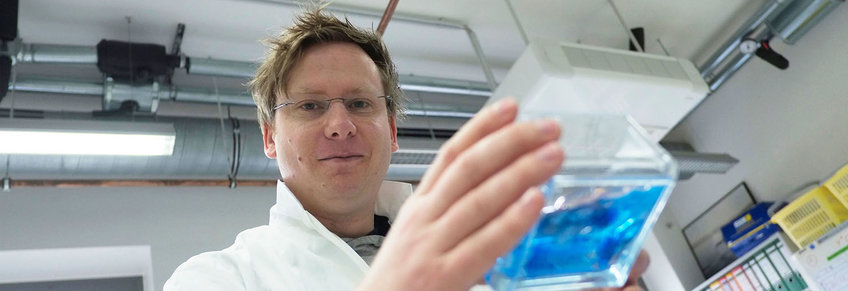
Peter Bieling
Research Group Leader, Systemic Cell Biology
Regulatory mechanisms of cell morphology
Press Releases
Research Interests
The primary focus of my research group on "Systems Biochemistry" is to reveal the molecular mechanisms that regulate changes in cell morphology through the cytoskeleton and the underlying polarization of the signaling molecules that control these processes. Instead of studying membrane polarity and cytoskeletal morphogenesis in their complex cellular environment, we aim to reconstitute these processes in minimal systems from purified components in vitro. This allows us to study and manipulate all biochemical activities in great detail to reveal the fundamental principles underlying self-organization of morphogenic signaling systems. As part of the MaxSynBio initiative and in synergy with recent research innovations in the Bastiaens department, we develop novel concepts and cutting edge methodology in systems biochemistry (multiprotein reconstitution, encapsulation) and combine these approaches with advanced fluorescence imaging (TIRFM, FLIM).
Selected Publications
Oosterheert W, Boiero Sanders M, Funk J, Prumbaum D, Raunser S, Bieling P (2024). Molecular mechanism of actin filament elongation by formins. Science
Source
Oosterheert W, Blanc FEC, Roy A, Belyy A, Sanders MB, Hofnagel O, Hummer G, Bieling P, Raunser (2023). Molecular mechanisms of inorganic-phosphate release from the core and barbed end of actin filaments. Nat Struct Mol Biol.
Source
Funk J, Merino F, Schaks M, Rottner K, Raunser S, Bieling P (2021). A barbed end interference mechanism reveals how capping protein promotes nucleation in branched actin networks. Nature Communications
Source
Funk J, Merino F, Venkova L, Heydenreich L, Kierfeld J, Vargas P, Raunser S, Piel M, Bieling P# (2019). Profilin and formin constitute a pacemaker system for robust actin filament growth. eLife
doi: 10.7554/eLife.50963.
Golding AE*, Visco I*, Bieling P#, Bement WM# (2019). Extraction of active RhoGTPases by RhoGDI regulates spatiotemporal patterning of RhoGTPases. eLife
doi: 10.7554/eLife.50471.
Bieling P#*, Hansen SD*, Akin O, Li TD, Hayden CC, Fletcher DA#, Mullins RD# (2018). WH2 and proline‐rich domains of WASP‐family proteins collaborate to accelerate actin filament elongation. EMBO J.
doi: 10.15252/embj.20179703.
Bieling P*, Li TD*, Weichsel J, McGorty R, Jreij P, Huang B, Fletcher DA#, Mullins RD# (2016). Force Feedback Controls Motor Activity and Mechanical Properties of Self-Assembling Branched Actin Networks. Cell 164(1-2):115-27
doi: 10.1016/j.cell.2015.11.057.
Bieling P, Telley IA, Surrey T (2010). A minimal midzone protein module controls formation and length of antiparallel microtubule overlaps. Cell 142(3):420-32.
doi: 10.1016/j.cell.2010.06.033.
Bieling P*, Laan L*, Schek H, Munteanu EL, Sandblad L, Dogterom M#, Brunner D#, Surrey T# (2007). Reconstitution of a microtubule plus-end tracking system in vitro. Nature 450(7172):1100-5
doi: 10.1038/nature06386;
# = (co-)corresponding author
* = co-first author

